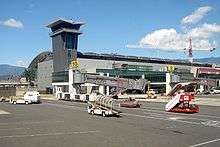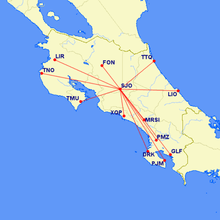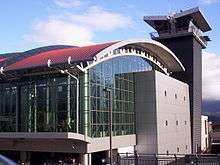Juan Santamaría International Airport
Juan Santamaría International Airport (Spanish: Aeropuerto Internacional Juan Santamaría) (IATA: SJO, ICAO: MROC) is the primary airport serving San José, the capital of Costa Rica. The airport is located in the city of Alajuela, 20 km (12 miles) west of downtown San José. It is named after Costa Rica's national hero, Juan Santamaría, a courageous drummer boy who died in 1856 defending his country against forces led by US-American filibuster William Walker.
Juan Santamaría International Airport Aeropuerto Internacional Juan Santamaría | |||||||||||
|---|---|---|---|---|---|---|---|---|---|---|---|
 | |||||||||||
 | |||||||||||
| Summary | |||||||||||
| Airport type | Public | ||||||||||
| Owner | Government of Costa Rica | ||||||||||
| Operator | Aeris Holdings Costa Rica under ADC & HAS and Andrade Gutiérrez Concesores | ||||||||||
| Serves | San José, Costa Rica | ||||||||||
| Location | Alajuela Province, Costa Rica | ||||||||||
| Hub for | |||||||||||
| Focus city for | |||||||||||
| Elevation AMSL | 921 m / 3,022 ft | ||||||||||
| Coordinates | 09°59′38″N 084°12′32″W | ||||||||||
| Website | https://sjoairport.com/ | ||||||||||
| Map | |||||||||||
 SJO Location in Costa Rica | |||||||||||
| Runways | |||||||||||
| |||||||||||
| Statistics (2019) | |||||||||||
| |||||||||||
The airport is a hub of a local airline Sansa Airlines, bases for Avianca Costa Rica and Volaris Costa Rica, and a focus city for Copa Airlines. It was the country's only international gateway for many years, but nowadays there is also an international airport in Liberia, Guanacaste. Both airports have direct flights to North and Central America and Europe, with the difference that Juan Santamaría International Airport also serves cities in South America and the Caribbean.
Juan Santamaría International Airport was once the busiest airport in Central America, but currently it is ranked second after Tocumen International Airport in Panamá. In 2016, Juan Santamaría International Airport received 4.6 million passengers (both international and domestic). In 2011, the airport was named the 3rd Best Airport in Latin America - Caribbean from the Airport Service Quality Awards by Airports Council International[3]
History
The airport was built to replace the previous one in downtown San Jose where Parque La Sabana is located today.[4] Funding was secured by the government in 1951[5] and construction proceed slowly until it was officially inaugurated on May 2, 1958.[6] It was initially called "Aeropuerto Internacional el Coco" after its location of the same name in the province of Alajuela. It would later be renamed in honor of Juan Santamaría. In 1961, funding was secured to build the highway that connects the airport to downtown San José.[7]
Ground transportation
The road access to the airport is on an exit at Route 1, and near the exit to Alajuela. There is a parking area with surcharge, plus a bus stop with plenty of services to San Jose downtown (with no exact schedule but with 24-hours bus service and approximately one service every 10 minutes during working hours). Licensed taxis are available in the airport and will generally accept both colones and U.S. dollars, but not other currencies. Costa Rican taxis are red with yellow triangles on the doors, ubiquitous all over the country, plus there is a special airport taxi service that is licensed and employs orange taxis. While the rail line linking downtown Alajuela with San José's Atlantic Station passes in close proximity to the airport, there is no station serving the airport and no rail service of any kind to the airport.
Facilities

The airport's main runway allows for operations of large, widebody aircraft. Currently, some scheduled flights are operated with Airbus A330 and A340, and Boeing 747, 767 and 777, for both passengers and freight. A Concorde landed in 1999 for that year's airshow.[8] Previously, the airport had a small hangar, called the "NASA" hangar, to house research aircraft, like the Martin B-57 Canberra high altitude aircraft, that were being operated in Costa Rica.[9] After that mission was completed, the hangar was removed.[10]
The largest operator in the airport is Avianca, followed by Copa Airlines which uses the Main Terminal (M). Sansa Airlines flights depart from the Domestic Terminal (D). No major changes were made to the terminal until November 1997 when the government issued a decree requesting participation of private companies to manage the operations of the airport.[11] After a few years of legal challenges and contract negotiations, Alterra Partners was given a 20-year concession and started managing the facilities in May 2001.[11] It was also expected that the company would finish the necessary expansion and construction of new facilities, however in March 2002, Alterra announced it would cease any further construction due to disagreements over financing and airport use fee billing with the government.[12] The dispute was extended for a few years and problems started at the terminal; in 2005, the International Civil Aviation Organization pointed out that the airport did not comply with safety regulations.[6] In July 2009, Alterra yielded the contract to a consortium composed of Houston-based Canadian-American company ADC & HAS and the Brazilian company, Andrade Gutierrez Concessoes (AGC) - subsidiary of the conglomerate Andrade Gutierrez.[13] In December 2009, Alterra Partners changed its name to AERIS Holdings, S.A.[13] In November 2010, Aeris announced it had finished the expansion and construction of new facilities with the installation of the 9th boarding bridge.[14]
The airport houses three business lounges for both special card holders and business class travellers; Avianca Club, Copa Club and VIP Lounge (for BAC Credomatic customers).[15]
Airlines and destinations
The following airlines have scheduled direct services to and/or from Juan Santamaría International Airport:
Passenger



- NotesArrival hall
- ^1 Condor's flights to and from Frankfurt fly via Santo Domingo, the airline has rights to transport passengers solely from Santo Domingo-Las Americas to San Jose.
Cargo

Statistics
Juan Santamaria International Airport is the largest and busiest airport in Costa Rica, having experienced a constant increase in traffic since its opening in 1958, boosted by the growing flow of tourists. The airport reached more than one million passengers per year for the first time in 1991 and having a record number of passengers in 2018. Traffic movements reached its highest number in 2017, while freight (in metric tons) reached a peak in 2011, with 98,609 tons.
 |
| Source: DGAC |
| Number of passengers | Percentage change | Number of movements | Freight (tonnes) | |
|---|---|---|---|---|
| 1960 | 209,624 | – | – | – |
| 1965 | 216,162 | 14,827 | 9,839 | |
| 1970 | 381,278 | 28,673 | 19,808 | |
| 1975 | 759,098 | 33,417 | 21,727 | |
| 1980 | 658,154 | 33,013 | 21,712 | |
| 1985 | 617,474 | 24,990 | 27,282 | |
| 1990 | 987,870 | 35,569 | 72,419 | |
| 1995 | 1,839,175 | 52,402 | 88,249 | |
| 2000 | 2,160,869 | 72,428 | 77,137 | |
| 2005 | 3,243,440 | 72,131 | 64,338 | |
| 2010 | 4,257,606 | 87,384 | 85,164 | |
| 2011 | 3,857,588 | 72,674 | 98,609 | |
| 2012 | 3,872,467 | 67,002 | 94,775 | |
| 2013 | 3,797,616 | 62,598 | 85,022 | |
| 2014 | 3,917,573 | 73,307 | 86,741 | |
| 2015 | 4,494,875 | 82,835 | 75,329 | |
| 2016 | 4,595,355 | 85,731 | 73,633 | |
| 2017 | 5,092,060 | 90,044 | 82,712 | |
| 2018 | 5,230,382 | 78,897 | 91,152 | |
| 2019 | 5,537,714 | 81,578 | 92,072 | |
| Source: Directorate General of Civil Aviation of Costa Rica | ||||
Top international destinations
| Airport | Arrivals | Departures | Total | 2014-2015 | Carriers | |
|---|---|---|---|---|---|---|
| 1 | Panama City, Panama1 | 405,608 | 415,602 | 821,210 | Air Panama, Avianca, Copa | |
| 2 | Houston, United States2 | 211,017 | 204,318 | 415,335 | Southwest, United | |
| 3 | Mexico City, Mexico | 189,358 | 191,635 | 380,993 | Aeroméxico, Interjet, Volaris | |
| 4 | Fort Lauderdale, United States | 188,381 | 188,457 | 376,838 | Jetblue, Southwest, Spirit | |
| 5 | San Salvador, El Salvador | 182,658 | 185,483 | 368,141 | Avianca, Volaris | |
| 6 | Miami, United States | 146,658 | 149,607 | 296,265 | American | |
| 7 | Atlanta, United States | 127,362 | 128,674 | 256,036 | Delta | |
| 8 | Guatemala City, Guatemala | 126,354 | 123,937 | 250,291 | Avianca, Copa, Volaris | |
| 9 | Bogotá, Colombia | 109,184 | 108,389 | 217,573 | Avianca, Wingo | |
| 10 | Madrid, Spain | 96,489 | 101,827 | 198,316 | Iberia | |
| 11 | Los Angeles, United States | 90,317 | 86,237 | 176,554 | Alaska, Delta | |
| 12 | Newark, United States | 91,460 | 83,374 | 174,834 | United | |
| 13 | Lima, Perú | 68,203 | 72,427 | 140,630 | LATAM, Avianca | |
| 14 | Orlando, United States | 53,046 | 54,702 | 107,748 | Jetblue, Spirit | |
| 15 | Dallas, United States | 51,585 | 53,735 | 105,320 | American | |
| 16 | Toronto, Canada | 51,136 | 46,897 | 98,033 | Air Canada, Air Transat, WestJet | |
| 17 | Paris, France | 47,348 | 46,619 | 93,967 | Air France | |
| 18 | Managua, Nicaragua | 44,560 | 46,125 | 90,685 | Copa | |
| 19 | Frankfurt, Germany | 40,980 | 42,908 | 83,8883 | Lufthansa, Condor | |
| 20 | Cancún, Mexico | 32,461 | 33,403 | 65,864 | Viva Aerobus, Volaris, | |
| 21 | Zurich, Switzerland | 31,959 | 32,244 | 64,203 | Edelweiss | |
| 22 | London, United Kingdom | 26,996 | 27,620 | 54,616 | British Airways | |
| 23 | Charlotte, United States | 27,183 | 24,233 | 51,416 | American | |
| 24 | Tegucigalpa, Honduras | 26,578 | 19,771 | 46,349 | Avianca, Copa | |
| 25 | Amsterdam, Netherlands | 16,756 | 15,166 | 31,922 | KLM | |
| Source: Directorate General of Civil Aviation. Air Transportation Statistical Yearbook (Years 2017,[20] and 2018[21]). Notes: ^1 Avianca and Copa fly to Panama City-Tocumen Airport, and Air Panama flies to Panama City-Albrook Airport. The data here is for traffic between SJO and all airports in Panama City. | ||||||
Accidents and incidents
- On May 23, 1988 a leased Boeing 727-100 (TI-LRC) operating the route San Jose-Managua-Miami, collided with a fence at the end of the runway in the Juan Santamaria International Airport, crashed at a nearby field next to a highway, and caught fire. The excess of weight in the front part of the airplane was the cause of the accident. There were no fatalities out of the 23 occupants.
- On January 16, 1990, SANSA Flight 32 crashed into the Cerro Cedral, a mountain shortly after take off from Juan Santamaria International Airport. All 20 passengers and 3 crew on board died in the crash.
References
- AIP - Part 3 Aerodromes Archived 2011-09-27 at the Wayback Machine
- (in Spanish) Resumen Estadístico del Transporte Aéreo 2019. Archived 2018-04-13 at the Wayback Machine
- "ASQ Award for Best Airport in Latin America - Caribbean" Archived 2012-02-18 at the Wayback Machine Airports Council International. 14 February 2012. Retrieved 2012-04-13
- Calvo, Rodrigo (2011-03-27). "Los mil rostros de La Sabana". La Nacion (in Spanish). Costa Rica. Archived from the original on 2011-04-04. Retrieved 2012-08-07.
- "En primber debate fueron aprobados el Arancel de Aduanas y la Ley de Pagos Internacionales". La Nacion (in Spanish). Costa Rica. 1951-11-26. Archived from the original on 2016-01-22. Retrieved 2015-12-26.
- Rojas, Ronny (2008-07-09). "El Santamaría incumple normas de seguridad". Al Dia (in Spanish). Costa Rica. Archived from the original on 2008-09-17. Retrieved 2012-08-07.
- "Hace 50 años, Sábado 11 de marzo de 1961". La Nacion (in Spanish). Costa Rica. 2011-03-11. Archived from the original on 2011-10-07. Retrieved 2012-08-07.
- Delgado, Edgar (1999-01-28). "Concorde impuso récord". La Nacion (in Spanish). Costa Rica. Archived from the original on 2016-03-04. Retrieved 2012-09-01.
- Ponchner, Debbie (2005-07-02). "Hoy despega de suelo tico la misión TCSP de la NASA". La Nacion (in Spanish). Costa Rica. Archived from the original on 2016-03-04. Retrieved 2012-09-01.
- Ponchner, Debbie (2007-05-05). "NASA realizará gran misión científica desde suelo tico". La Nacion (in Spanish). Costa Rica. Archived from the original on 2016-03-04. Retrieved 2012-09-01.
- Feigenblatt, Hazel (2001-05-05). "Aeropuerto a manos privadas hoy". La Nacion (in Spanish). Costa Rica. Archived from the original on 2016-03-04. Retrieved 2012-08-07.
- Loaiza, Vanessa (2002-03-15). "Suspenden obras en aeropuerto". La Nacion (in Spanish). Costa Rica. Archived from the original on 2016-03-04. Retrieved 2012-08-07.
- Loaiza, Vanessa (2009-12-04). "BID presta $45 millones para ampliar Juan Santamaría". La Nacion (in Spanish). Costa Rica. Archived from the original on 2016-03-04. Retrieved 2012-08-07.
- Loaiza, Vanessa (2010-11-10). "Concluye modernización de aeropuerto Santamaría". La Nacion (in Spanish). Costa Rica. Archived from the original on 2010-11-14. Retrieved 2012-08-07.
- "VIP Services - Juan Santamaría International Airport". sjoairport.com. Retrieved 2020-01-06.
- "Safety Precautions: COVID-19". Aeroméxico. July 2020. Retrieved July 19, 2020.
- "Avianca plans its international flights from Colombia". Nicolás Larenas (in Spanish). July 2020. Retrieved July 29, 2020.
- "Avianca reviews the restart of its flights in Central America". Nicolás Larenas (in Spanish). August 2020. Retrieved August 8, 2020.
- "Copa Airlines would restart its flights to these international destinations". Nicolás Larenas (in Spanish). July 2020. Retrieved August 4, 2020.
- Anuario Estadístico de Transporte Aéreo 2017. Dirección General de Aviación Civil de Costa Rica
- Anuario Estadístico de Transporte Aéreo 2018. Dirección General de Aviación Civil de Costa Rica
External links
![]()
- Official website (in Spanish)
- Official website (in English)
- Dirección General de Aviación Civil de Costa Rica Costa Rican Aviation Authority
- Sansa Costa Rica Sansa Costa Rica Airline
- OpenStreetMap - Alajuela